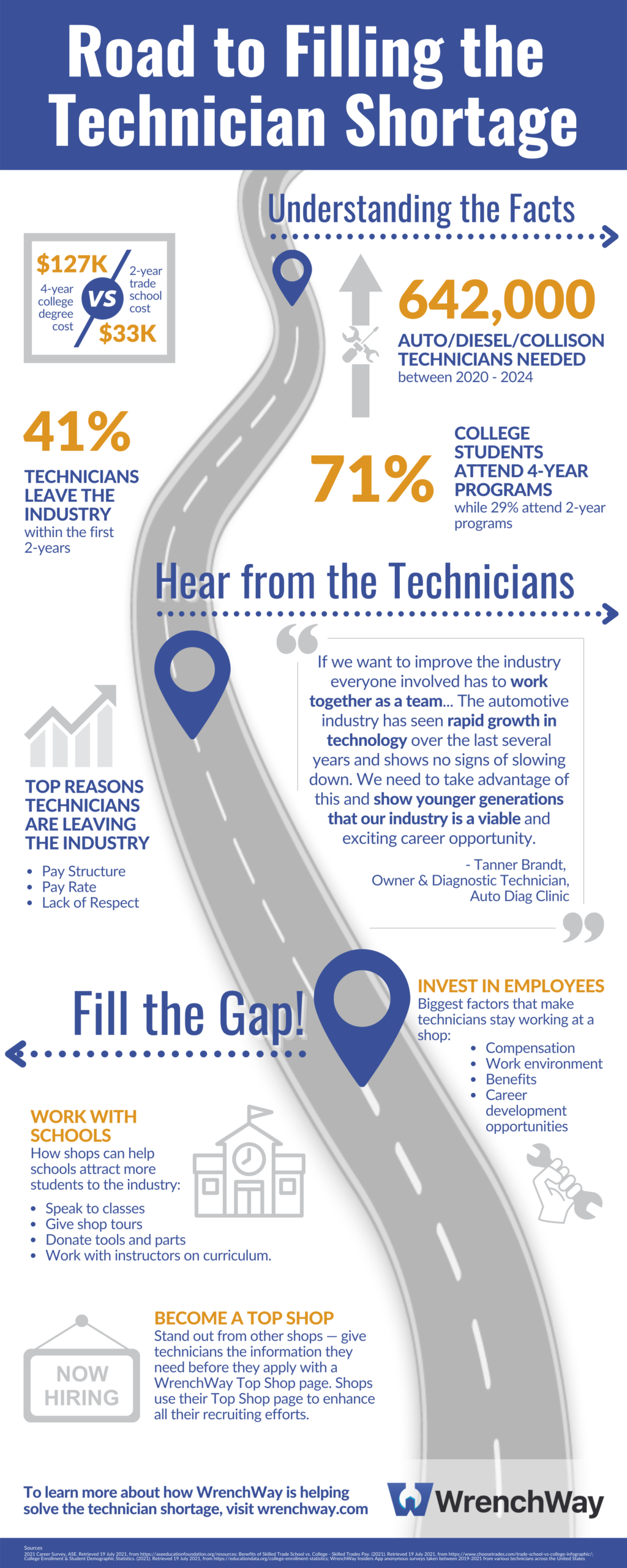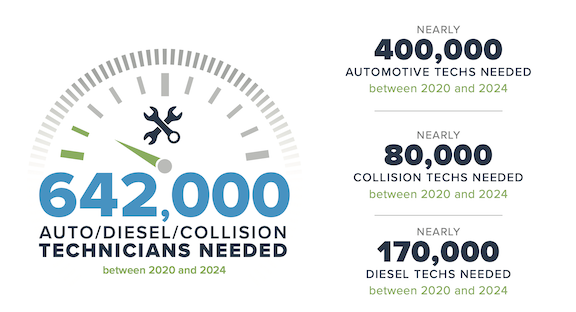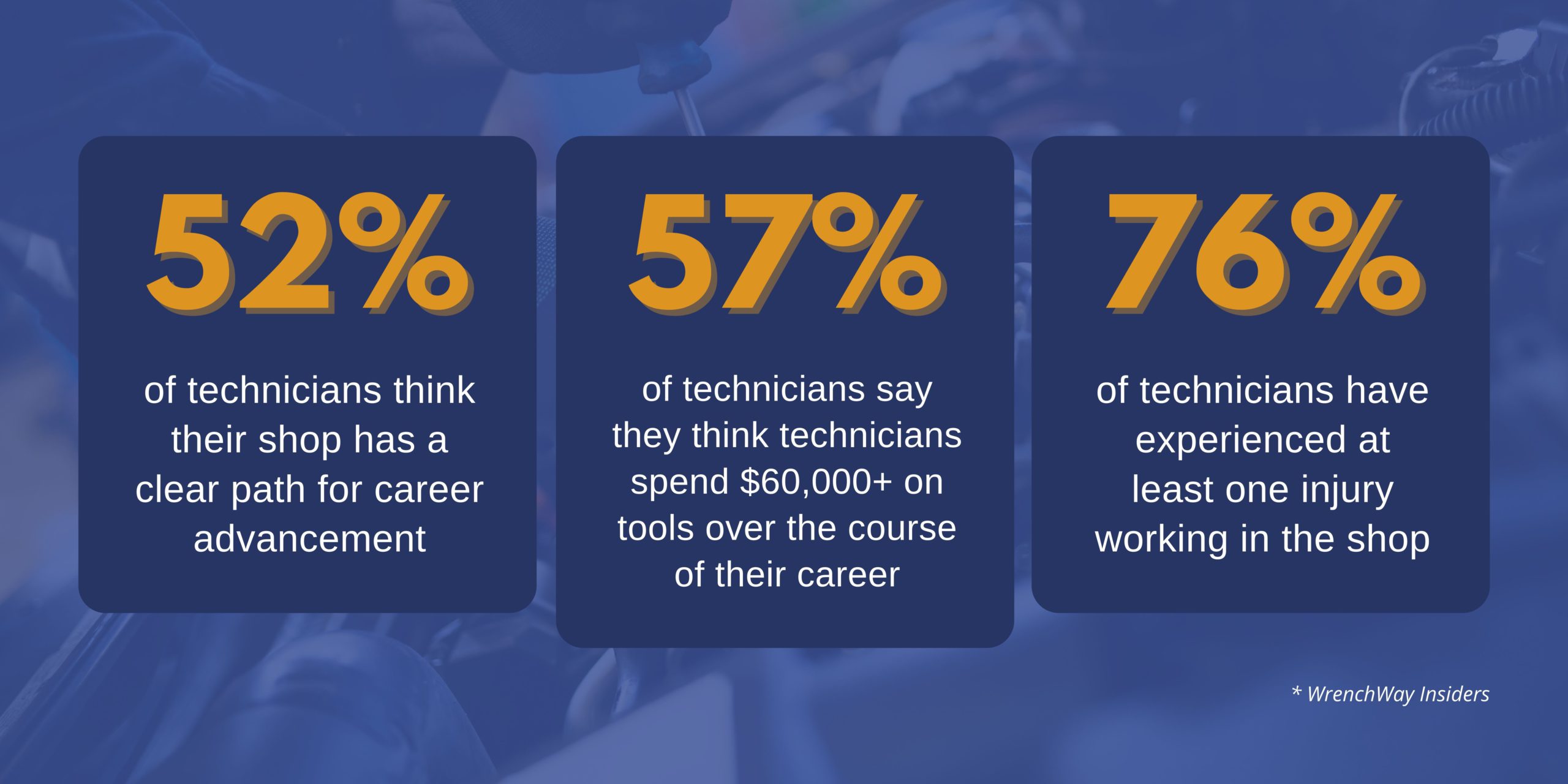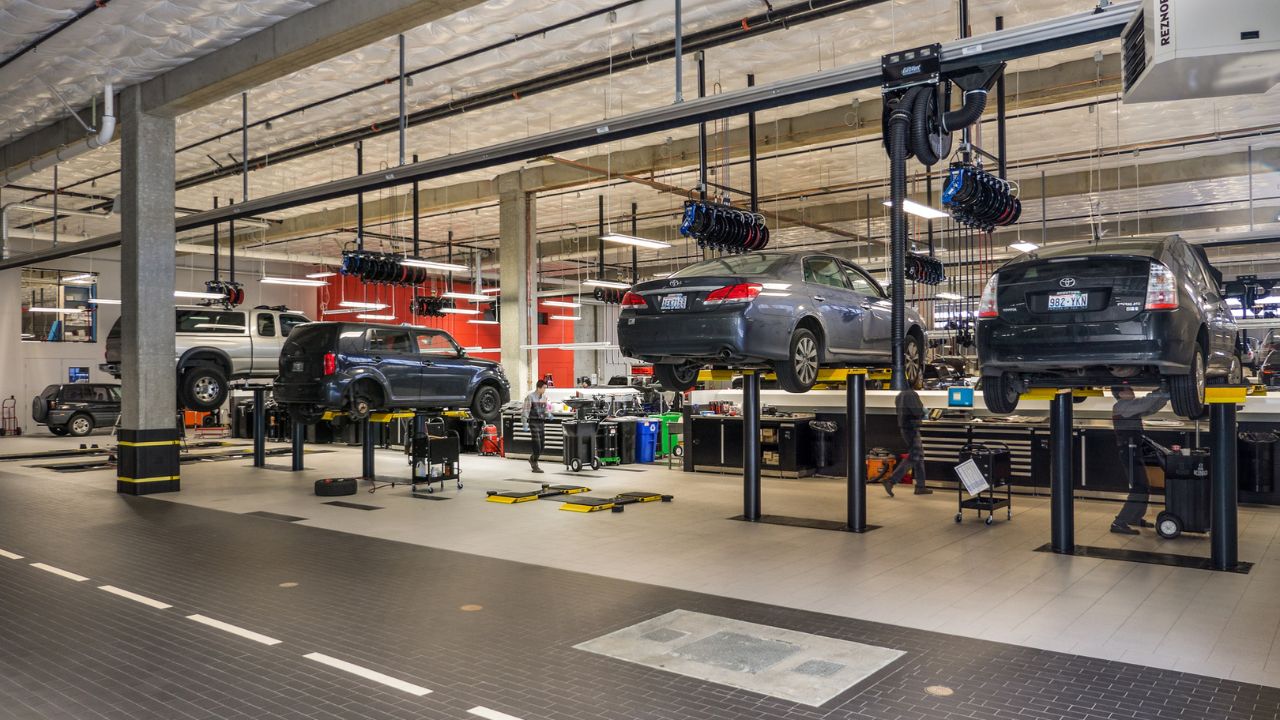The U.S is in route to see a shortage of 642,000 technicians by 2024, if trends continue, according to a new study by TechForce Foundation. Not only is it an issue to get young people interested in the industry, but also to keep the ones that are new to the industry. Millennials are three times more likely to change jobs than baby boomers, and average four or more jobs by the time they are 24-years-old. We have to sit back and ask ourselves, how did this happen? Why is there a technician shortage? And what are we going to do to turn around this detrimental problem in the industry?
It is clear there isn’t just one major problem feeding into the national technician shortage. In the article below, we will give an overview of the main factors contributing to the growing technician shortage and what changes need to happen to see the shortage start to reverse.
Photo by: Auto Service World
Why is There a Technician Shortage?
Negative Industry Perception
One of the biggest factors affecting the technician shortage is society, as a whole, looks down upon the industry. The industry is still perceived as a “dirty,” unprofessional career. Part of this stigma leads back to the shops and the way technicians present themselves. It’s important shops start to hold technicians to a higher standard. Shops need to ensure technicians are being professional at work, staying up-to-date on training, wearing a clean uniform, and overall promoting the intelligence required to work in the industry. Technicians are very smart individuals, and we need to start broadcasting the knowledge they hold.
We all know cars are becoming extremely advanced and being built more and more like computers every single day. It is no longer just your basic engine, brakes, and steering wheel. Advancements in technology are happening every day and becoming a big focus within the automotive industry. Cars now have the power to brake automatically, let you know when someone is in your blind spot, have a reverse camera, and so much more. The industry is slowly turning away from that classic “down and dirty” career and is on a path to become more of an information technology (IT) career. Of course, there will still be those classic responsibilities of changing oil and rotating tires, but it’s important to accept the change in technology that is happening in the industry. When looking at problems within cars, it is not always an easy tell to what is wrong. There has been such an advancement in technology that you need to be able to comprehend advanced coding and act on bigger issues.
It’s critical shops are staying up-to-date on training to ensure their technicians can keep up with the new technology. If a customer comes to your shop to get their car fixed, and your technicians don’t know how to fix it, you’re going to lose a lot of business. Furthermore, this problem will only continue to get worse.
Schools Need to Promote the Industry
Let’s be honest—When talking with a school counselor as a student, did they bring up career opportunities in the automotive or diesel industry? Probably not.
Dating back to when baby boomers were in school, the students who weren’t excelling academically were the ones teachers encouraged to get involved in the trades. What a terrible precedent to set for those working in the automotive industry!
Fast forward to today, students are still being taught they need to go to a four year university if they want to be successful and make good money. Guidance counselors and instructors are stuck in an outdated mindset that if you go to college and get a corporate desk job, then society will consider you to be successful.
With fewer teachers and counselors talking about what a career as a technician has to offer, students are no longer excited about or interested in becoming a technician. People just assume automotive technicians will always be around when their car breaks down, but if we don’t start broadcasting this as a valuable career option it will slowly start to disappear, and there will be no one left to fix our cars.
In order to start tackling the technician shortage, we need to start with changing the negative perception of the technician career at the school level. Teachers and counselors need to be more focused on helping kids find a career that truly interests them, and educating them on all the different available career paths. If there is a student who is passionate about the automotive industry and gifted at working with their hands, why are we pushing them into something they don’t want to do when there are options out there for them?
Choosing to become a technician, electrician, or plumber is an excellent career choice, and no one should be looked down upon for choosing a job in the skilled trades.
Outdated School Curriculum
Schools need to recognize the evolving technology in the industry, and make sure they are teaching future technicians up-to-date curriculum. We’re seeing a lot of issues with new technicians coming into the industry, only to find out the skills they learned in schools are not the skills needed to be successful in the shop. This isn’t the technician’s fault. It’s the schools fault for not being taught the materials needed for them to succeed.
One way shops can help prepare students for the shop is by joining advisory committees and working with instructors to ensure students are learning the correct curriculum for when they come into the shop. No one is expecting an 18-year-old, right out of high school, to be an expert, but it is important they meet shop expectations on the basics. Shops have the best understanding of what skills are needed from new technicians, and they need to communicate that to the schools.
Work Environment in Auto Repair Shops
Work environment and company culture are becoming much bigger factors when it comes to people choosing a job. New generations look for jobs where they can feel like they are a part of a family or something special. Technicians want to be able to walk into the shop every morning and love their job, not dread it. They should feel excited to go to work and know they are going to be able to enjoy their day. That goes along the lines of ensuring technicians are feeling appreciated. No one wants to go into a job everyday where they feel unimportant or are not getting credit for the good work they do.
Some ways to show you appreciate your technicians could include:
- Hosting team outings or parties
- Taking them out to dinner
- Providing lunch
- Giving them a random day off
It’s the small actions that show you care that are going to keep technicians happy and make them want to stay in the industry.
In addition, there are also basic needs within the work environment that can make or break a shop. Some things to consider:
- Is your shop air conditioned and/or heated?
- Is the equipment in your shop updated and in good condition?
- Is your shop using technology to streamline processes and make it easier for technicians to focus on their job?
It is the shop’s responsibility to ensure they have an up-to-date and high-quality work environment. Having poor working conditions can make work more stressful and harder to enjoy. Technicians shouldn’t have to worry about being comfortable and taken care of when they walk into the shop every morning.
Lack of Advancement Opportunities in the Industry
Are there opportunities in your shop for technicians to advance?
One of the most common advancement opportunities for technicians is to become a service manager at a shop. For some technicians, this would be a great opportunity. However, not everyone wants to be a manager or has the skill set to manage a group of people. It can be a difficult job to manage a team, and the best technicians don’t always make the best managers. They might not have the people and leadership skills needed to be a shop manager.
Another, and more difficult advancement opportunity could be owning a shop of their own. Starting a business is not an easy job, and not everyone is built to be a business owner. That is a tough role to take on and not every technician can go out there and own their own shop. Plus, most of them don’t want to handle the stress that comes with owning a business.
Being an automotive technician can put a lot of pressure on the body as you age. What happens when your technicians are 45-years-old, not ready to retire, but they can’t physically do the work any more? It would be a great opportunity if the automotive industry provided certified mentorship programs. Mentorship programs are a great opportunity for experienced technicians to share their knowledge with new technicians while staying involved in the industry, but taking away some of that physical labor. There is so much knowledge and experience from these older technicians, and we need to take advantage of their knowledge and keep it within the industry.
Having a clear and organized plan is crucial when developing a career development program. One of the biggest factors is to communicate with the technicians in your shop. Technicians shouldn’t worry or be shocked when you want to sit down and have a conversation with them. Meetings and conversations should be periodic and expected by all technicians.
Identify the opportunities you have to offer. Show technicians the options you provide for career growth, and how they can get there. Get to know your technicians and how they see their future in the shop. Ask them to define their goals, and write them down. Every technician is going to have different goals and values. It is important to identify these goals so you can provide guidance and help pave their career path.
Once you’ve identified goals and a career path, communication needs to be regular. Create time to check in with technicians to see what they are doing to complete their goals, if there are any barriers, and how you can help them get there. Once a goal has been achieved, new goals should be made. Career development is not something that can be done in one meeting. It’s a continuous process as they advance in their career.
Compensation
When thinking about career paths that are known to make a lot of money, an automotive technician doesn’t immediately pop into everyone’s head.
Right now, the average salary for an automotive technician in the United States is about $22 an hour. Over half of automotive technicians in the United States don’t think their salary is enough for the cost of living in their area.
Technician salary is a hot topic. Oftentimes, the debate is not about how much technicians get paid, but more about how they get paid.
Hourly vs. Flat Rate
Technicians are generally paid by either the amount of work they produce (“flat rate”), or by the amount of time they work. Choosing the right incentive plan for technicians is tricky. Shop owners and service managers want to drive productivity while remaining competitive, yet they don’t want to break the bank.
Many technicians aren’t fans of flat rate because their income is directly affected when their shop is experiencing low volumes. There are also times when technicians get put on a job that takes longer than it pays. However, well-experienced technicians have the opportunity to make a lot of money on a flat rate pay structure by producing well over 40 hours of labor in a 40-hour work week.
Some technicians won’t even consider flat rate and prefer an hourly pay plan. A handful of technicians prefer this because they have a more predictable income. They know how many hours they work a week and how much they will get paid. It is a constant income whether the shop is slow or busy, and you can expect the same pay rate. However, there can also be cons to this pay plan. There could be a lack of productivity because technicians know they will be getting paid the same wage regardless. This also provides a smaller potential for an increase in income. In flat rate, if you have a busy week, you will see a dramatic increase in your income. If you’re busy hourly, you will see the same paycheck at the end of the week.
Overall, there is no right or wrong pay structure. They both will have their pros and cons. It really depends on the preference of the technician. It is important for shop owners/managers to sit down with their technicians to discuss the pay plan they prefer. Technicians are all motivated by different factors, and it is important to put them in an environment where they can perform their best.
Working Together to Solve the Technician Shortage
The technician shortage isn’t going to be a problem that gets fixed overnight. Hopefully, the trends change and we see an increase of interest in technician careers. However, it is important that we consider the factors that are negatively affecting the industry and work collectively to fix them. There is a lot of value and opportunities within this industry, and it is time that people see it for what it is.










